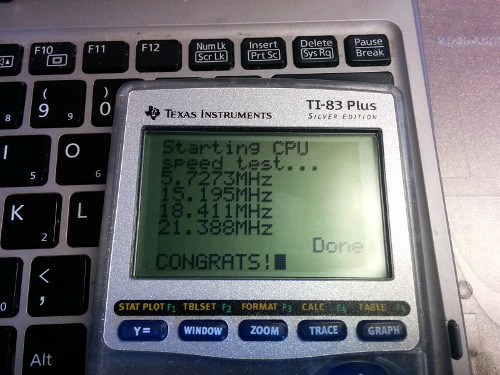KermMartian wrote:
I'd be very interested in hearing more about this purported 30MHz overclock; I suspect you might have gotten lucky with your ASIC (which you said was a TA2). I'll have to check my TI-83+SE to see if that was a TA1 or TA2, as I'm intrigued by this possibility.
Yeah, I probably just got lucky. When I first removed the resistor on R07D, I soldered a replacement resistor (with a guessed resistance value that I thought would give me 21mhz), put the calculator back together, and was very surprised when the test printed out 30mhz. The text was very gargled coming from the program. However, the OS still worked nicely and it was the fastest I'd seen a t84 go. At first I thought it might've been a miscalculation from the program, but running my (non bricked at the time) t84+ side to side proved that my SE most likely really was rocking 30mhz. Exciting! 
I'll try to get pictures as soon as possible, too! And good luck with your calc.
DrDnar wrote:
Nice work. What does the inside look like? It still must have been very delicate soldering. You might be able to get even high speeds by adding wait states, however the clock speed tester doesn't compensate for wait states. Also, the wait states will make the calculator seem a little slower. Depending on the hardware, they may only be needed for flash, so the OS would be slower, but assembly RAM programs might run fast. Regardless, we're seeing more and more people reporting that the calculator handles well 20 MHz, so I wonder why TI didn't give the TI-84+CSE that little extra speed.
Thanks! I'll be honest, the inside does look a little messy. I accidentally broke off one of the solder pads from the original resistor and had to very carefully solder the wire to the remaining material. It wasn't very stable at all, so I put a dab of hot glue on there to ensure nothing would budge. Nothing too bad though, and I'm sure many will find it fairly easy to do. I would get pictures, but I don't want to be embarrassed... 
That sounds like an interesting idea. I'm not sure I'll be able to implement it though, so I'll have to leave it up to one of you guys.
I can confirm that it runs very well at 20-21mhz, I really wish TI treated the CSE better. ez80? Better asic for higher clock speeds? Dunno, anything would've been good.
DrDnar wrote:
The TA1 ASIC is very different. It has fewer pins (each pin on a chip costs about a penny, so reducing pin count saves money), so the pinout is totally different. So you might well have hacked the wrong circuit. (Unless you already did the following:) You need to look for a similar arrangement of a capacitor and pair of resistors to hack.
Looking at my t84+ board in front of me, the similar circuit seems to be in the same relative location, and the capacitor and resistors are even named the same ("C05D", "R08D", "R07D"), the only difference being that the asic pins corresponding to them are on the side instead of the bottom. I knocked off R07D just like I did with the others, soldered on a new resistor, and booted it. It showed the "RAM Cleared" screen like normal but froze when it completed the operation. Afterwards I tried putting back the original resistor value of ~1100 ohms and it didn't work either, so I'm lost. Maybe I accidentally messed up another circuit. I'll look at it again later.
CalebHansberry wrote:
That's really amazing...! The first CSE overclock, and it needs it desperately! I'd want to try this, but I wouldn't stand a pot sticking out the top, I'd want it simply OCed to the highest it can while being known to be stable, permanently.
But wow, you could've possibly bricked your CSE like your 84+ x.x
Thank you! You don't have to use a potentiometer, any resistor will do. Then it'll look just like any other CSE, but 10x awesomer.
Don't worry about my bricked calculators, they all died for a good cause. 




















